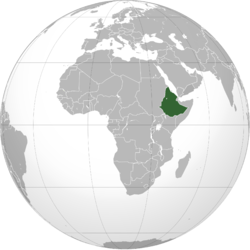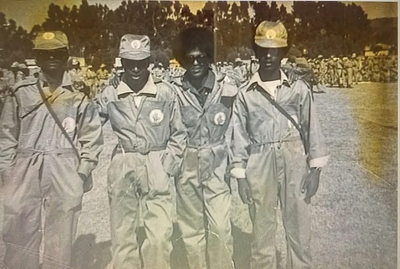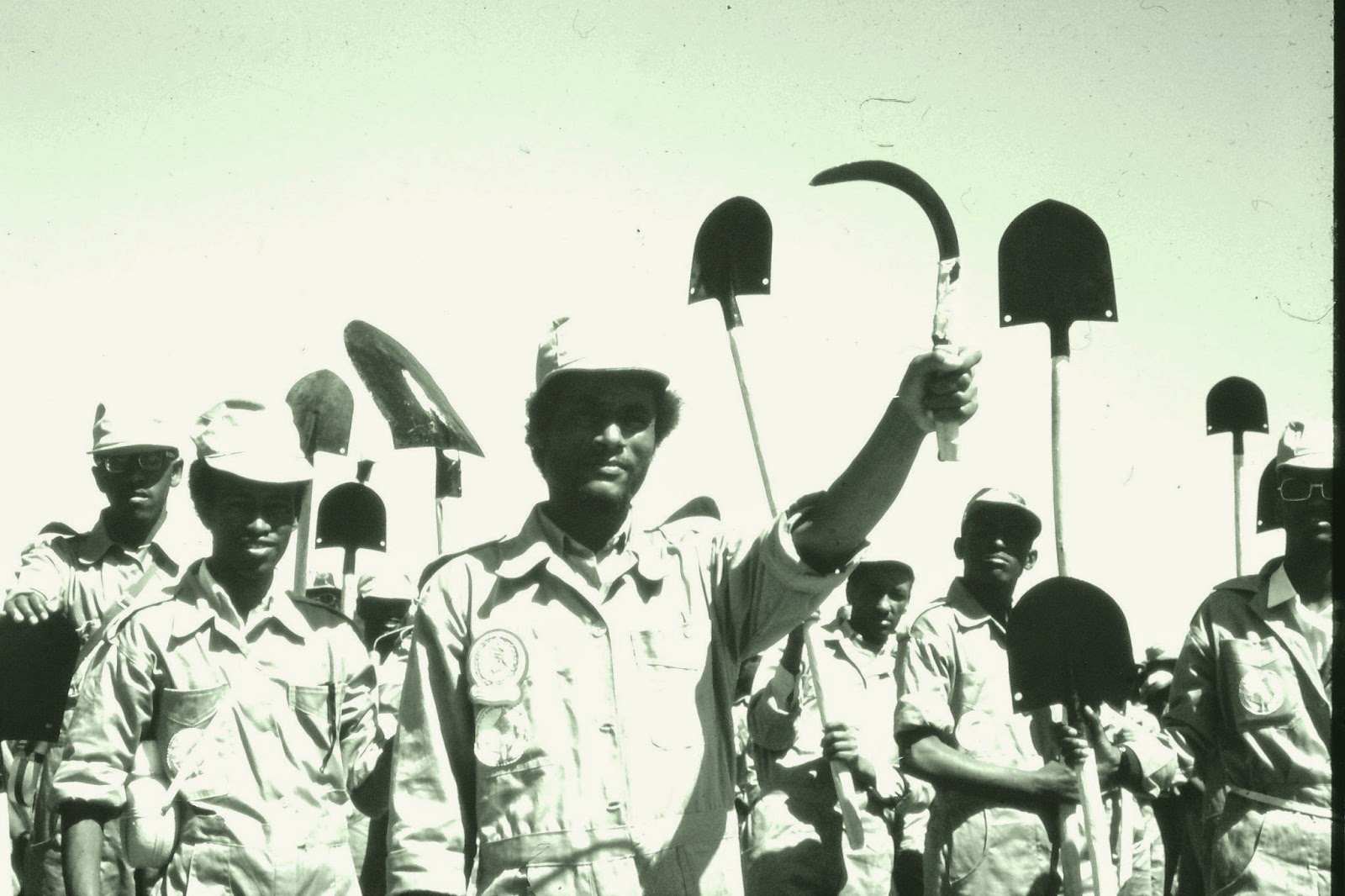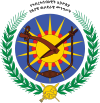Provisional Military Government of Socialist Ethiopia (1974–1987)
More languages
More actions
| Provisional Military Government of Socialist Ethiopia የኅብረተሰብአዊት ኢትዮጵያ ጊዜያዊ ወታደራዊ መንግሥት | |
|---|---|
| 1974–1987 | |
Anthem: ኢትዮጵያ ኢትዮጵያ ኢትዮጵያ ቅደሚ (English: Ethiopia, Ethiopia, Ethiopia be first" | |
 | |
| Capital and largest city | Addis Ababa |
| Official languages | Amharic |
| Dominant mode of production | Socialism |
| Government | Marxist–Leninist military junta |
• Head of State (1974) | Aman Adom |
• Head of State (1974-1974) | Mengistu Haile Mariam |
• Head of State (1974-1977) | Tafari Benti |
• Head of State (1977-1987) | Mengistu Haile Mariam |
| History | |
• Established | 1974 |
• Dissolution | 1987 |
| Area | |
• Total | 1,221,900 km² |
| Population | |
• 1987 estimate | 46,706,229 |
The Provisional Military Government of Socialist Ethiopia, also known as the Derg, was a socialist military junta that ruled Ethiopia between the Ethiopian revolution of 1974 and the establishment of a civilian government in 1987.
History
Pretext to the Revolution
Revolution
In September 1974, the absolute monarchy of Ethiopia led by Emperor Haile Selassie was overthrown. The revolution was supported by students, teachers, trade unions, and the military.[1]
In April 1976, the Derg released the National Democratic Revolution Program, which included land reform, nationalization of industries, and reorganization of unions.[2]
Power Struggles and Consolidation
Nationalisation, Land Reform and the Zemecha-Campaign
Nationalisation and Urban-Reform
Land-Reform
The legal framework of the land reform was provided by a series of decrees, or "proclamations" of the Provisional Military Administrative Council (PMAC), the country's ruling military group. These proclamations, issued between 4 March 1975 and 17 September 1977, form a coherent whole.[3](There were more proclamations regarding Rural Land, at least until 1982, but these had a minor effect on the groundwork being laid ealier)[4]. Land reform was not conceived simply as a matter of breaking up large estates, but above all as the problem of creating a new political and social organization in the countryside to defeat the landlords and allow the peasants to control their land and their affairs.[3] These proclamations are, in order:
- Proclamation No.31 of 1975 ("A Proclamation to Provide for the Public Ownership of Rural Lands")
- Proclamation No. 71 of 1975 ("Peasant Associations Organization and Consolidation Proclamation.")
- Rural Land Fee and Agricultural Activities Income Tax Proclamation[3]
- Proclamation No. 130. Sept. 1977 ("A Proclamation on Formation of nation-wide Peasant Associations")[4]
Zemecha-Campaign (1974-1976)
Following the Ethiopian Land Reform, in early 1975, the Derg created the Ediget Behibret Zemecha (Development through Cooperation Campaign), which encompassed the closure of the Addis Abeba University in the beginning of 1975, so that six thousand university students and fifty thousand secondary school students could be sent to 437 places in the countryside. This was intended to teach and politicize the peasant, and help develop the rural masses. In the course of the campaign, university students taught peasants about civil rights, land ownership and hygiene, created awareness of land redistribution, and participated in the formation of peasant associations, bringing literacy and building schools, clinics and latrines. The AAU was reopened in the 1976/1977 academic year. [5]
Determining the correct approach to implement the Zemecha was difficult. To this end, Zemecha leaders proposed the following remedies:
- Campaigners were to go only were they knew the roads, cultural traits, lifestyle and languages of the people
- Dissemination of information was to take place at market-places, schools, churches, mosques, religious centers and official gathering places
- Priority was to be given to educating local administrators, spritual leaders, and influential residents.Speak the language local to the area without a translator[6]
Following advice was given to Zemcha-Campaigners (Amharic: Zemach):
- Speak in the local language without translator
- Do not claim the abilty to complete a task when there is the slightes possibility that you could not
- Do not give empty promises
- Be honest and sincere
- Avoid opposing traditional culture, but if absolutely necessary to do so, emply the utmost care as not to arouse the people's ire
- Reject arrogance
- Be receptive towards peoples ideas, but if opposition is called for, make a thorouh explanation
- Live like the people
- Do not shocase superiorty in public
- Speak cautiously and be a good listiner
- In oder to explain personal opinions, make use of clear and concise examples
- Show fratenal and filial concern
- Respect Individuals in Private Conversations
- Be Patient
- Think Before you Speak[6]
Succsesses of the the Zemecha Campaign:

The Zemecha Campaign, via its Alphabetization Program, thaught over 350,000 peasants how to read, write, and peform arithmetic in their vernacular language. Initially, six languages were selected for pedagogicial use: Amharic, Afaan Ormo, Tigrinya, Wolaitigna, Somali, Afarigna, Sidamigna and Hadiygna. Teaching material for the first five were completed early in the Zemecha campaign.[6] These 350,000 peasants were only thaught by 40% of the camapigners due to political distrubances. Comparing this to the previous governent ( under Haile Selassie I), which had a literacy rate of 6%, a benchmark which has not been moved passed in about 60 years of political control, the results were commendable.[8]
The campaigners taught health education to a million people, built 155 schools and 296 clinics (more than 50% of Ethiopias total at the time), trained 1500 midwives, and increased the number of nurses by 40%. They additionally vaccinated 1,250,000 people against various diseases, planted 2,000,000 trees, and vaccinated over 300,000 cattle. Additionally, 6 million people were organized into 19,000 farmers cooperatives and 3,700 woman's associations.[8] Additionally, many wells, roads, wooden bridges, meeting halls, latrines, health centres and market places were built, in addition to water pumps, water wheels wind mills, and even medium range transistor radios, from locally-sourced materials. Total costs for this were 17 Million ETB (at the time 8.5 Million Dollars), one-third of the initially planned cost. [6]
Criticism and Problems of the Zemecha-Campaign:

116 Campaigners were killed. Sometimes, campaigners were sent to the wrong regions, and were therefore place before linguistic and cultural barriers. The campaigners backround, differing widely in age, exerience, ability and level of education, were not functionally classified. Some station chiefs were selected only on the basis of educational backround, rather than on organisatioal capacity.
There existed differences in the subjective and objective conditions in different parts of the country. E.g., the proclamation "Land to the tiller" did not carry the same signifcance for a Tigrean, Gondare or Gojame farmer, as land has been locally controlled for centuries (in contradistinction to the south which only were made part of the Ethiopian Empire through Meneliks conquests, the Agar Maqnat). [6]
This, in addition to the still relatively obscure class distinctions in the north, as strong blood relations tied the farmer to the feudal administrator, and the reforestation programmes, in the heavily eroded landscapes in the north, did not generate the dramatic short term effects that generated enthusiasm for the revolution as elsewhere. This also lead to the campaigners being viewed as outsiders or external threats. Major obstructions also emenated from the former local officials, counterrevolutionary members of the police force, and armed landords. The movement also was subject to sabotage, sometimes emenating from neighbouring countries.[6]
Some Zemecha-participants were also unwilling to participate, rejecting to work as medical or agricultural personell , leading to desertions (especially after the Zemecha was extended from the initial one year programme). In total, 69 stations were abandoned, and 6,502 students relocated due to political distrubances, whereas 14 stations composed of 1984 campaigners were closed down due to resistance from the campaigners themselves. A lack of ideological coherence among the students also led to a dissemination of often contradictory political messaging, and some students refused to learn from the masses.[6]
Opposition to the Derg
Nej Shibir and Qey Shibir (White Terror and Red Terror)
Ogaden-War
Emergence of Ethnonationalist Groups
Formation of the Workers Party of Ethiopia
Famine of 1984-1986
Dissolution of the Derg
Structure and Ideology
Politics and Policy-Effects
Economics
References
- ↑ Andargachew Tiruneh (1990). The Ethiopian Revolution (1974 to 1984). [PDF] PhD Thesis, London School of Economics.
- ↑ Patrick Gilkes (1982). Building Ethiopia's Revolutionary Party. [PDF] Middle East Research and Information Project.
- ↑ 3.0 3.1 3.2 Marina Ottaway (1977). Land Reform in Ethiopia 1974-1977 (pp. 80--84). African Studies Review, Vol. 20, No. 3, Peasants in Africa, 79-90. doi: 10.2307/523755 [HUB]
- ↑ 4.0 4.1 Dessalegn Rahmato (1984). Agrarian Reform in Ethiopia (p. 37). [PDF] Uppsala: Scandinavian Institute of African Studies.
- ↑ Edited by: Elina Oinas, Henri Onodera and Leena Suurpää (2018). What Politics? Youth and Political Engagement in Africa: 'Students' Participation in and Contribution to Political and Social Change in Ethiopia (Abebaw Yirga Adamu and Randi Rønning Balsvik)'. Youth in a Globalizing World, Vol.6. BRILL. doi: 10.1163/j.ctvbqs5zx.22 [HUB] [LG]
- ↑ 6.0 6.1 6.2 6.3 6.4 6.5 6.6 Paulos Milkias (1980). ZEMECHA--AN ASSESSMENT OF THE POLITICAL AND SOCIAL FOUNDATIONS OF MASS EDUCATION IN ETHIOPIA (pp. 20-23). Northeast African Studies, Vol. 2, No. 1.
- ↑ Berhane S. Tadese (2021-02-06). "The tumultuous years of the 1970s in Contemporary Ethiopian History: A Memoir, 1975: Serving in the National Youth Campaign “Zemecha”" borkena. Retrieved 2023-06-04.
- ↑ 8.0 8.1 Paulos Milkias (1980). Mass Campaign in Ethiopia — the Political Economy of Education for National Reconstruction (p. 189). The Journal of Educational Thought (JET) / Revue de la Pensée Éducative, Vol. 14, No. 3, 187-195.
- ↑ "ETHIOPIA: Images of the Ethiopian Revolution; Zamacha Campaign, 1974" (2012-01-21). corfu blues and global views. Retrieved 2023-06-04.


